2018 KIA K900 belt
[x] Cancel search: beltPage 4 of 544

ii
1
2
3
4
5 6
7
8 I
IntroductionHow to use this manual / Fuel requirements / Vehicle break-in process /Vehicle data collection and event data recorders
Your vehicle at a glance
Exterior overview / Interior overview / Instrument panel overview / Engine compartment
Seat and safety features of your vehicle
Seats / Seat belts / Child restraint system / Air bag
Features of your vehicleSmart key / Door locks / Trunk / Windows / Hood / Fuel filler lid / Panoramic sunroof / Steering wheel / Mirrors /
Instrument cluster / Lighting / Wipers & Washers / Climate control system / Audio system / Etc.
Driving your vehicleBefore driving / Engine start/stop button / Transmission / Brake system /
Cruise control system / Advanced Smart Cruise Control system / Winter driving / Vehicle load limit / Etc.
What to do in an emergencyRoad warning / Emergency while driving / Emergency starting / Engine overheat / TPMS / Flat tire / Towing / Etc.
MaintenanceEngine compartment / Maintenance service / Engine oil / Engine coolant / Brake flui\
d / Washer fluid / Parking
brake / Air cleaner / Wiper blades / Battery / Tire and wheels / Fuses / Light bulbs / Etc.
Specifications, Consumer information and Reporting safety defects
Index
Table of contents
KH USA FOREWORD:2016 12/28/2016 3:34 PM Page 3
Page 10 of 544
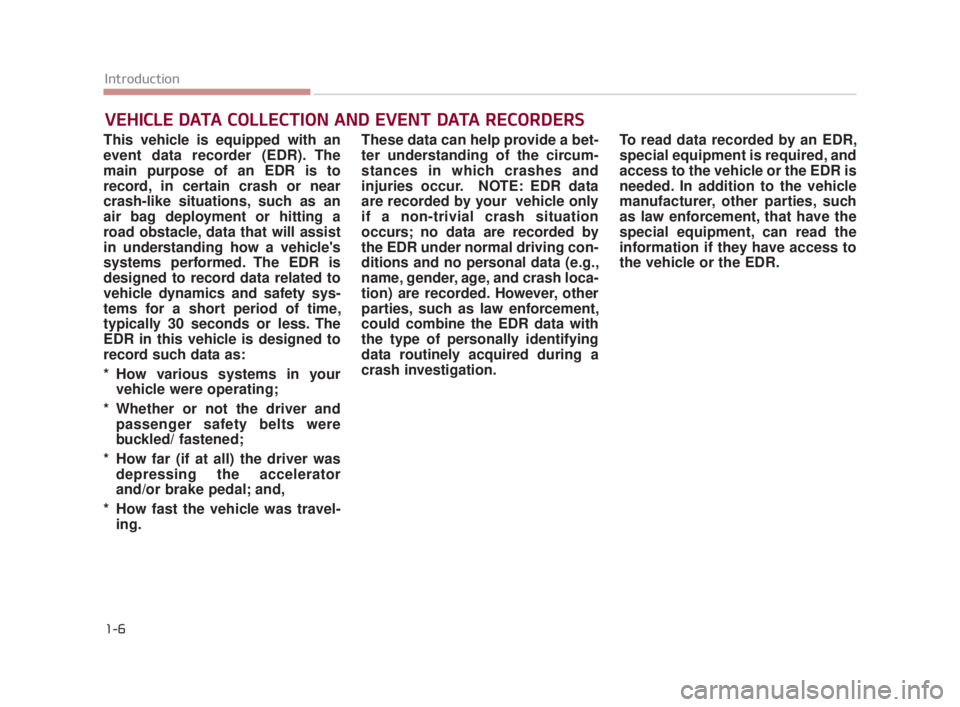
1-6
Introduction
VEHICLE DATA COLLECTION AND EVENT DATA RECORDERS
This vehicle is equipped with an
event data recorder (EDR). The
main purpose of an EDR is to
record, in certain crash or near
crash-like situations, such as an
air bag deployment or hitting a
road obstacle, data that will assist
in understanding how a vehicle's
systems performed. The EDR is
designed to record data related to
vehicle dynamics and safety sys-
tems for a short period of time,
typically 30 seconds or less. The
EDR in this vehicle is designed to
record such data as:
* How various systems in yourvehicle were operating;
* Whether or not the driver and passenger safety belts were
buckled/ fastened;
* How far (if at all) the driver was depressing the accelerator
and/or brake pedal; and,
* How fast the vehicle was travel- ing. These data can help provide a bet-
ter understanding of the circum-
stances in which crashes and
injuries occur. NOTE: EDR data
are recorded by your vehicle only
if a non-trivial crash situation
occurs; no data are recorded by
the EDR under normal driving con-
ditions and no personal data (e.g.,
name, gender, age, and crash loca-
tion) are recorded. However, other
parties, such as law enforcement,
could combine the EDR data with
the type of personally identifying
data routinely acquired during a
crash investigation.
To read data recorded by an EDR,
special equipment is required, and
access to the vehicle or the EDR is
needed. In addition to the vehicle
manufacturer, other parties, such
as law enforcement, that have the
special equipment, can read the
information if they have access to
the vehicle or the EDR.
KH USA 1:2016 12/1/2016 9:43 PM Page 6
Page 19 of 544
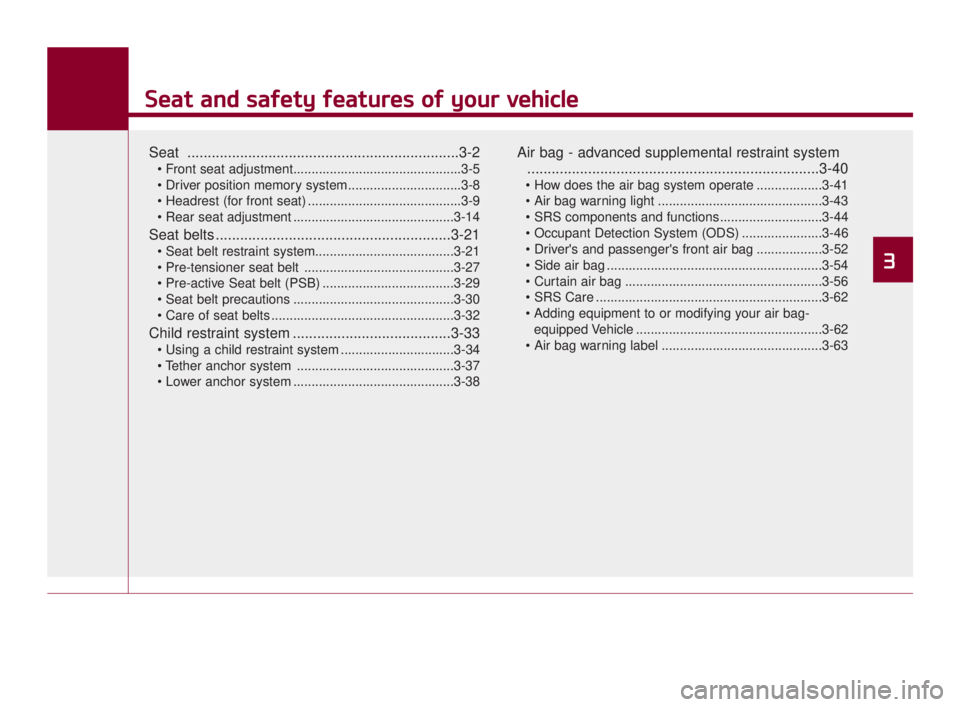
Seat and safety features of your vehicle
3
Seat and safety features of your vehicle
3
Seat and safety features of your vehicle
3
Seat and safety features of your vehicle
Seat ...................................................................\
3-2
..........................................3-9
............................................3-14
Seat belts ..........................................................3-21
.........................................3-27
....................................3-29
............................................3-30
..................................................3-32
Child restraint system .......................................3-33
...............................3-34
...........................................3-37
............................................3-38
Air bag - advanced supplemental restraint system........................................................................\
3-40
..................3-41
.............................................3-43
......................3-46
..................3-52
...........................................................3-54
......................................................3-56
..............................................................3-62
equipped Vehicle ...................................................3-62
............................................3-63
3
KH USA 3:2018 4/18/2017 9:33 AM Page 1
Page 21 of 544
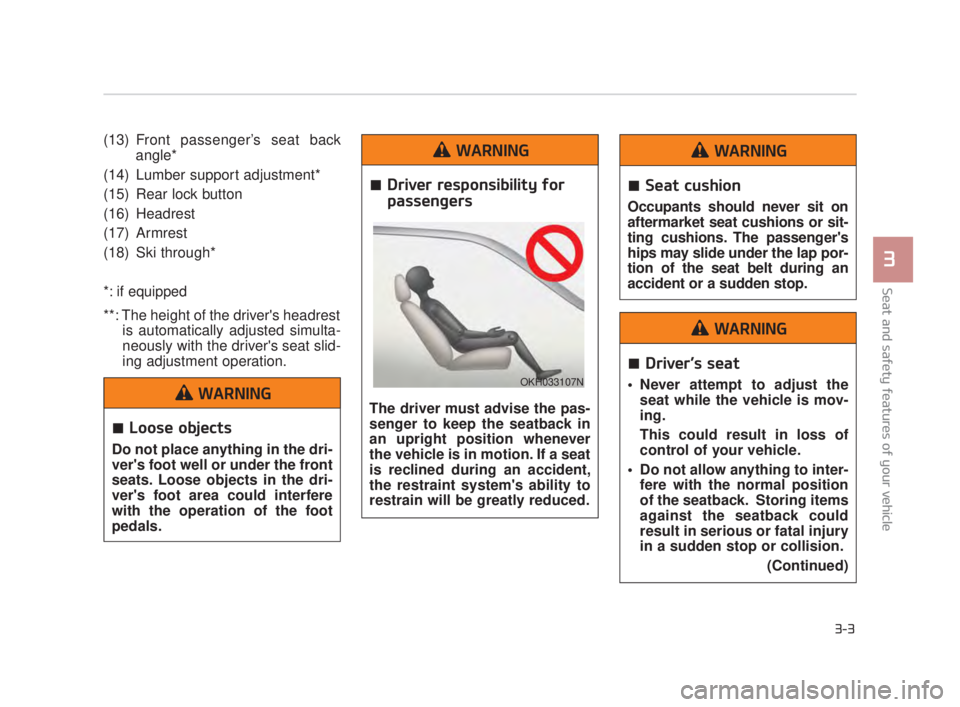
Seat and safety features of your vehicle
3
3-3
(13) Front passenger’s seat backangle*
(14) Lumber support adjustment*
(15) Rear lock button
(16) Headrest
(17) Armrest
(18) Ski through*
*: if equipped
**: The height of the driver's headrest is automatically adjusted simulta-
neously with the driver's seat slid-
ing adjustment operation.
Loose objects
Do not place anything in the dri-
ver's foot well or under the front
seats. Loose objects in the dri-
ver's foot area could interfere
with the operation of the foot
pedals.
WARNING
Driver responsibility for
passengers
The driver must advise the pas-
senger to keep the seatback in
an upright position whenever
the vehicle is in motion. If a seat
is reclined during an accident,
the restraint system's ability to
restrain will be greatly reduced.
WARNING
OKH033107N
Seat cushion
Occupants should never sit on
aftermarket seat cushions or sit-
ting cushions. The passenger's
hips may slide under the lap por-
tion of the seat belt during an
accident or a sudden stop.
WARNING
Driver’s seat
Never attempt to adjust theseat while the vehicle is mov-
ing.
This could result in loss of
control of your vehicle.
Do not allow anything to inter- fere with the normal position
of the seatback. Storing items
against the seatback could
result in serious or fatal injury
in a sudden stop or collision.
(Continued)
WARNING
KH USA 3:2018 4/18/2017 9:34 AM Page 3
Page 22 of 544
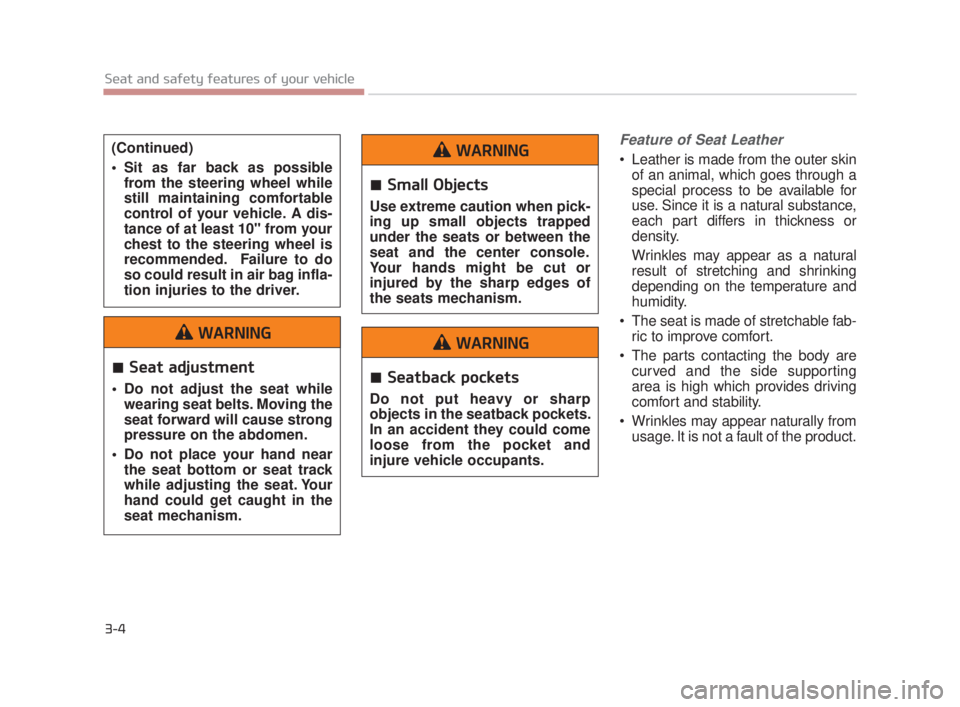
Feature of Seat Leather
Leather is made from the outer skinof an animal, which goes through a
special process to be available for
use. Since it is a natural substance,
each part differs in thickness or
density.
Wrinkles may appear as a natural
result of stretching and shrinking
depending on the temperature and
humidity.
The seat is made of stretchable fab- ric to improve comfort.
The parts contacting the body are curved and the side supporting
area is high which provides driving
comfort and stability.
Wrinkles may appear naturally from usage. It is not a fault of the product.
3-4
Seat and safety features of your vehicle
(Continued)
Sit as far back as possiblefrom the steering wheel while
still maintaining comfortable
control of your vehicle. A dis-
tance of at least 10" from your
chest to the steering wheel is
recommended. Failure to do
so could result in air bag infla-
tion injuries to the driver.
Seat adjustment
Do not adjust the seat whilewearing seat belts. Moving the
seat forward will cause strong
pressure on the abdomen.
Do not place your hand near the seat bottom or seat track
while adjusting the seat. Your
hand could get caught in the
seat mechanism.
WARNING
Small Objects
Use extreme caution when pick-
ing up small objects trapped
under the seats or between the
seat and the center console.
Your hands might be cut or
injured by the sharp edges of
the seats mechanism.
WARNING
Seatback pockets
Do not put heavy or sharp
objects in the seatback pockets.
In an accident they could come
loose from the pocket and
injure vehicle occupants.
WARNING
KH USA 3:2018 4/18/2017 9:34 AM Page 4
Page 23 of 544
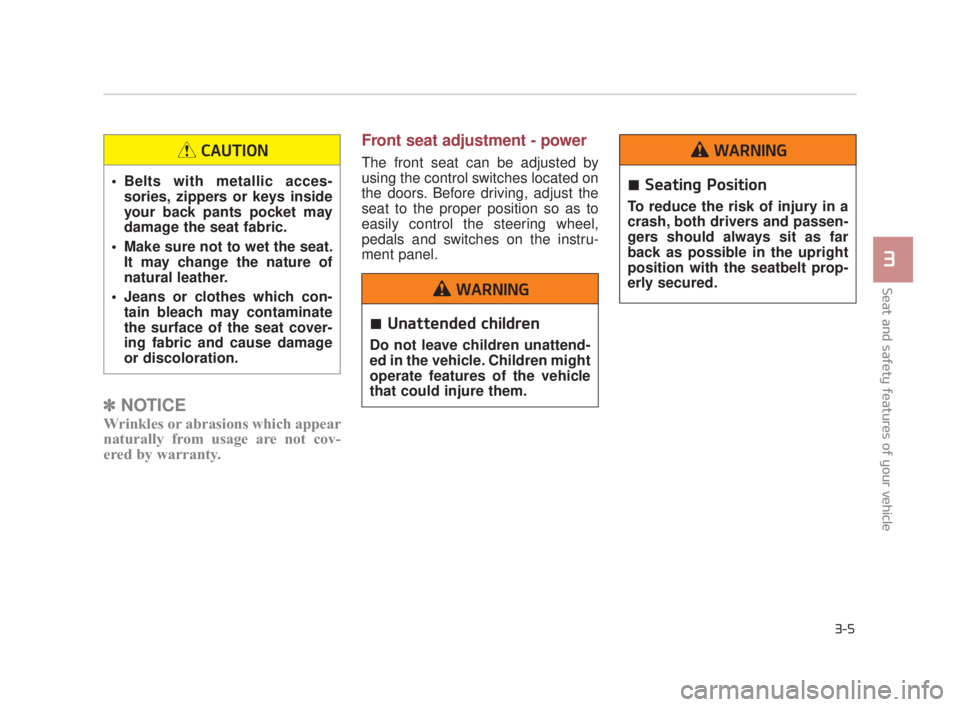
Seat and safety features of your vehicle
3
3-5
✽NOTICE
Wrinkles or abrasions which appear
naturally from usage are not cov-
ered by warranty.
Front seat adjustment - power
The front seat can be adjusted by
using the control switches located on
the doors. Before driving, adjust the
seat to the proper position so as to
easily control the steering wheel,
pedals and switches on the instru-
ment panel.
Unattended children
Do not leave children unattend-
ed in the vehicle. Children might
operate features of the vehicle
that could injure them.
WARNING
Seating Position
To reduce the risk of injury in a
crash, both drivers and passen-
gers should always sit as far
back as possible in the upright
position with the seatbelt prop-
erly secured.
WARNING
Belts with metallic acces-
sories, zippers or keys inside
your back pants pocket may
damage the seat fabric.
Make sure not to wet the seat. It may change the nature of
natural leather.
Jeans or clothes which con- tain bleach may contaminate
the surface of the seat cover-
ing fabric and cause damage
or discoloration.
CAUTION
KH USA 3:2018 4/18/2017 9:34 AM Page 5
Page 32 of 544
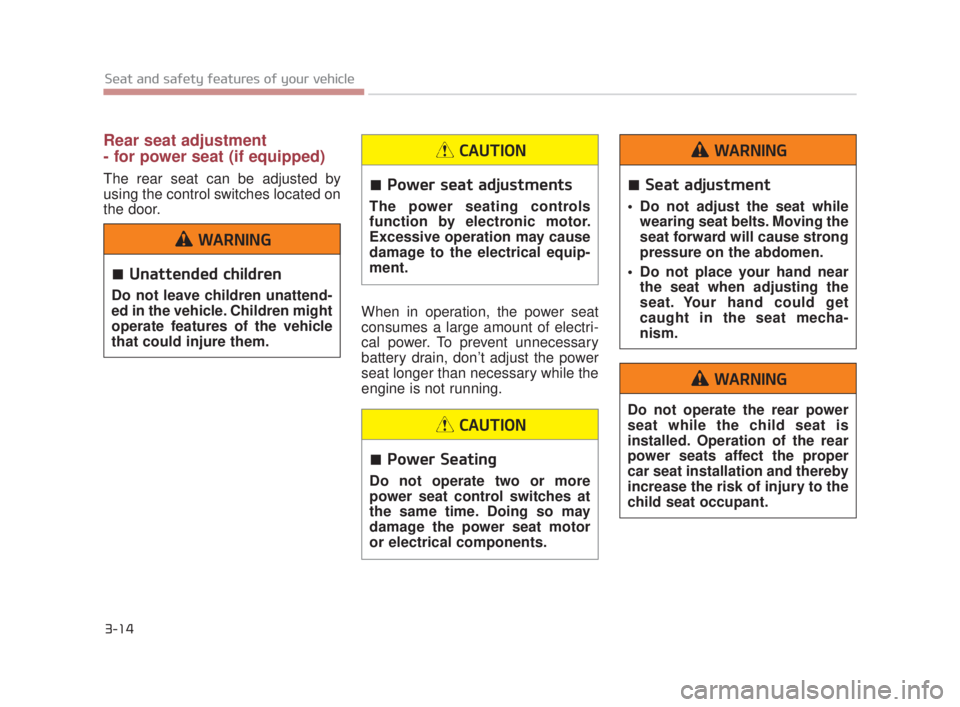
3-14
Seat and safety features of your vehicle
Rear seat adjustment
- for power seat (if equipped)
The rear seat can be adjusted by
using the control switches located on
the door.When in operation, the power seat
consumes a large amount of electri-
cal power. To prevent unnecessary
battery drain, don’t adjust the power
seat longer than necessary while the
engine is not running.Seat adjustment
Do not adjust the seat whilewearing seat belts. Moving the
seat forward will cause strong
pressure on the abdomen.
Do not place your hand near the seat when adjusting the
seat. Your hand could get
caught in the seat mecha-
nism.
WARNING
Do not operate the rear power
seat while the child seat is
installed. Operation of the rear
power seats affect the proper
car seat installation and thereby
increase the risk of injury to the
child seat occupant.
WARNING
Power seat adjustments
The power seating controls
function by electronic motor.
Excessive operation may cause
damage to the electrical equip-
ment.
CAUTION
Power Seating
Do not operate two or more
power seat control switches at
the same time. Doing so may
damage the power seat motor
or electrical components.
CAUTION
Unattended children
Do not leave children unattend-
ed in the vehicle. Children might
operate features of the vehicle
that could injure them.
WARNING
KH USA 3:2018 4/18/2017 9:34 AM Page 14
Page 39 of 544
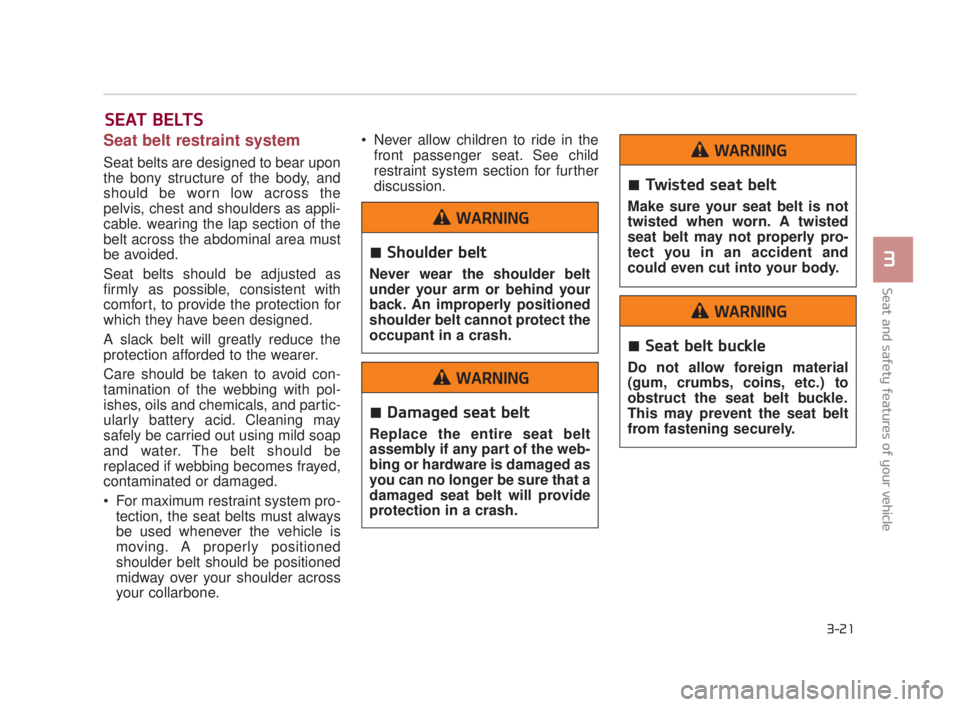
Seat and safety features of your vehicle
3
3-21
Seat belt restraint system
Seat belts are designed to bear upon
the bony structure of the body, and
should be worn low across the
pelvis, chest and shoulders as appli-
cable. wearing the lap section of the
belt across the abdominal area must
be avoided.
Seat belts should be adjusted as
firmly as possible, consistent with
comfort, to provide the protection for
which they have been designed.
A slack belt will greatly reduce the
protection afforded to the wearer.
Care should be taken to avoid con-
tamination of the webbing with pol-
ishes, oils and chemicals, and partic-
ularly battery acid. Cleaning may
safely be carried out using mild soap
and water. The belt should be
replaced if webbing becomes frayed,
contaminated or damaged.
For maximum restraint system pro-tection, the seat belts must always
be used whenever the vehicle is
moving. A properly positioned
shoulder belt should be positioned
midway over your shoulder across
your collarbone. Never allow children to ride in the
front passenger seat. See child
restraint system section for further
discussion.
SEAT BELTS
Shoulder belt
Never wear the shoulder belt
under your arm or behind your
back. An improperly positioned
shoulder belt cannot protect the
occupant in a crash.
WARNING
Damaged seat belt
Replace the entire seat belt
assembly if any part of the web-
bing or hardware is damaged as
you can no longer be sure that a
damaged seat belt will provide
protection in a crash.
WARNING
Twisted seat belt
Make sure your seat belt is not
twisted when worn. A twisted
seat belt may not properly pro-
tect you in an accident and
could even cut into your body.
WARNING
Seat belt buckle
Do not allow foreign material
(gum, crumbs, coins, etc.) to
obstruct the seat belt buckle.
This may prevent the seat belt
from fastening securely.
WARNING
KH USA 3:2018 4/18/2017 9:34 AM Page 21